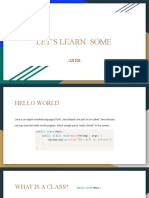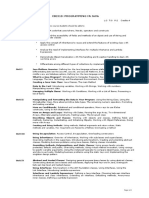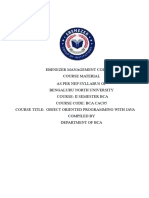0 ratings0% found this document useful (0 votes)
23 viewsJava
Uploaded by
venkata seshuCopyright
© © All Rights Reserved
Available Formats
Download as PDF or read online on Scribd
0 ratings0% found this document useful (0 votes)
23 viewsJava
Uploaded by
venkata seshuCopyright
© © All Rights Reserved
Available Formats
Download as PDF or read online on Scribd
You are on page 1/ 5
i222, 9:33 M PDF js viewer
ORACLE academy oracle.com
Academy
Java Foundations — Course Objectives
Overview
This course of study engages students with litte programming experience. Students are introduced to object-oriented concepts,
terminology, and syntax, and the steps required to create basic Java programs using hands-on, engaging activities, Students will learn
the concepts of Java programming, design object-oriented applications with Java and create Java programs using hands-on, engaging
activities. This course prepares students for the Oracle Java Certfied Foundations Exam (120-811)
Available Curriculum Languages:
‘+ Arabic, Simplfiod Chinese, English, French, Indonesian, Japanese, Brazilian Portuguese, Russian, Spanish
Duration
‘© Recommended total course time: 80 hours*
‘© Professional education credit hours for educators who complate Oracle Academy training: 30
“Course time inludos instruction salf-studynomework, practices, projects and assessment
Target Audiences
Educators
‘© Technical, vocational, and 2- and 4-year college and university facuity members who teach computer programming,
information communications technology (ICT), ora related subject at a foundational level
‘+ Secondary and vocational schoolteachers wha teach computer programming,
Students
‘© Students who wish leam Java programming and build thelr Object-Oriented Programming experience using Java.
‘+ This course is a suitable foundational class for computer science majors, and when taught in sequence with Java
Programming may be used to prepare studants for the AP Computar Science A oxam.
Prerequisites
Suggested
‘© Oracle Academy Workshop - Gotting Started with Java Using Alice
‘© Oracle Acadamy Workshop - Creating Java Programs with Greanfoot
‘© Oracle Academy Course - Java Fundamentals
Suggested Next Courses
‘+ Oracle Acadomy Course - Java Programming
opin 202 Orc ent ces Cad Jovn, nd NySOL ao seeed aden ct Cec andre ae, iar ames ay beaten of Drege nae
hitpssimyacedemy.orace.comiplayerplay7ir_sessionid$5510J008449154J&classroom i
11661868in_Ip_1d°68697891 15
i222, 9:33 M PDF js viewer
Lesson-by-Lesson Topics and Objectives
‘Section 1 — Introduction
4-4 About the Course
© Identify course goals and objectives
© Understand the course environment
‘2 Describe the course learning strategy
4-2.A Brief History
‘Show examples of how people interact with Java in their daily lives
‘Summariza the history of Java
Understand Java technology product groups
ting up Java,
Understand the difference between the JOK and JRE
Understand the diference between java and class fies
Dascrite the purpose of an intagrated development environment (IDE)
‘Add an existing Java file into a Java project
13
occef ooo
Section 2 — Java Software Development
2:1 The Software Development Process
Understand the Spiral Model of development
Recognize tasks and subtasks of the Spiral Mode!
Recognize what happens when stops are ignorad
Identify sofware features
Understand how features are gradually implemented
at is my Program Doing?
Understand how Java is read line by line
‘Set and use breakpoints
End statemants with semicolons (:)
‘Organiza code using whitespace and othar conventions
‘Create comments
22
000008 co000
23 Introduction to Objoct-Oriantod Programming Goncapts
‘© _ Differentiate between procedural and object-oriented programming
© Understand a class as a blueprint for an object
© Understand a class is used to craate instances af an abject
© Model objects as a combination of
= Proportias (data fields)
Behaviors (methods)
Section 3 — Java Data Types
3-4 What is a Variable?
© Understand the benefits of variables.
(© Identity four main types of variables:
+ (boolean, int, double, Sting)
© Declare and assign values to variables
© Name variables according to conventions
3-2 Numeric Data
2 Differentiate intager data types (oyte, shor, int, long)
© Differentiate floating point data types (float, double)
© Manipulate and do math with numeric data
2 Use parentheses and order of operations
3-3 Textual Data
Use the char data type
Use Strings
Concatenate Strings
Understand escape sequences
Understand print statements better
Capi 202 Crack onder nes Cac Jv, re MySOL ae rere kaon cl Cn aris fin ther ames ye ade of epee ome
hitpssimyacedemy.orace.comiplayerplay7ir_sessionid$5510J008449154J&classroom i
11661868in_Ip_1d°68697891
i222, 9:33 M PDF js viewer
‘3-4 Converting Between Data Types
Take advantage of automatic promotion
And when to be cautious with promotions
© Cast variables to other data types
‘= And when to be cautious with casting
2 Parse Strings as numeric values
3-5 Keyboard Input
© Understand user input
© Greate a JOptionPane to callect user input
2 Use a Scanner to collect input from the console
2 Use a Scanner to collect input from a fle
© Understand how a Scanner handles tokens and delimiters
Section 4 — Java Methods and Library Classes
4-1 What js @ Method?
‘Svucture code within a class
Instantiato an object
Understand the benefits of methods
Use the dot operator (,) to access an objoct's fields and methods
‘Supply arguments to a method
Return values from a method
1 import Declaration and Packages
‘Acoass a class by using its fully qualifiad name
Describe the function of the import statement
Uso the import statoment to access a ciass in a package
Understand the purpose of an asterisk in an import statement
Identify packages that are automatically imported
2 String Class
Local the String class in the Java API documentation
Understand the methods of the String class
‘Compare two String abjacts lexicagraphically
Find the location of a substring in a Sting object,
Extract a substring from a Sting object,
ye Random Class
Describe the purpose and uses of random numbers in Java programming
Identify mothads of the Random class that obtain random numbers
‘Obtain random numbers in a ranga of numbers
Understand the purpose of the random number seed
e Math Class
Understand the methods of the Math class
Use methods of the Math class to perform mathematical calculations
Use fields of the Math Class
42
£ £
Section 5 — Decision Statements
5-1 Boolean Expressions and ifelse Constructs
‘2 Doclaro, initialize, and use boolean variables
‘Compare boolean expressions using relational operators
Greate an if statement
Create iffolsa constructs
‘Compare Strings
5-2 Understanding Conditional Execution
ascribe conditional execution
Describe logical operators
Understand “shor circuit” evaluation of logical operators
BBulld chained if constructs
itch Statement
‘Greate a switch contral structure
‘Compare iielse constructs with switch control structures,
Understand the purpose of the break koyword
ooog
Capi 202 Crack onder nes Cac Jv, re MySOL ae rere kaon cl Cn aris fin ther ames ye ade of epee ome
hitpssimyacedemy.orace.comiplayerplay7ir_sessionid$5510J008449154J&classroom i
11661868in_Ip_1d°68697891
i222, 9:33 M PDF js viewer
Section 6 — Loop Constructs
© 61 forLoops.
© Understand the components of the standard for lop
Understand how to create and use a for loop
Understand variabla scope
Understand debugging techniques
Explain how infinite loops eccur in Java
ile and do-uile Loops
Use a while loop in a Java program (pre-test)
Uso a do-while loop in a Java program (post-iost)
Understand when one loop type may be more beneficial than anether
ing broak and continue Statements
Uso a broak statoment to exit a loop
Use a continue statement to skip part of a loop
Explain the need for loop comments
+ 62
£
o00§ 0008 0000
Section 7 ~ Creating Classes
= 7-1 Greating a Class
(© Create a Java testimain class
© Greate a Java class in your IDE
© Use conditionals in methods
2 Translate specifications or a description into fields and behaviors
+ 7-2 Instantiating Objects
© Understand the memory consequences of instantating objects
2 Understand object referencos
‘2 Undarstand the diference between stack and heap memory
© Understand how Strings are special objects
© 7-3 Constructors
Understand default values
Crash the program with a null reference
Understand the default constructor
Write a constructor that accepts arguments
Initialize fields with @ constructor
Uso this as an object reference
verioading Methods
Understand the effects of multiple constructors in a class
Dafine overloading of a method
Explain the method signature
Understand when overioading is and isnt possible
\bject Interaction and Encapsulation
Understand object interaction in greater detail
Use the private modifier to define class variables
Understand the purpose of getter methods
Understand the purpose of setter methods
tatic Variablos and Methods
ascribe a static variable and demonstrate its use within a program
Describe a static method and demonstrate its use within a program
Understand how to use the final keyword with static variables
. 74
. 78
+ 76
e008 00009 00009 co0000
Section 8 — Arrays and Exceptions
‘© 8-1 One-dimensional Arrays
© Create and initialize one-dimensional arrays
© Modify an array element
© Traverse a one-dimensional array by using a for loop.
© Identify the cause of an ArrayIndexOutOfBoundsException
Capi 202 Crack onder nes Cac Jv, re MySOL ae rere kaon cl Cn aris fin ther ames ye ade of epee ome
hitpssimyacedemy.orace.comiplayerplay7ir_sessionid$5510J008449154J&classroom i
11661868in_Ip_1d°68697891
i222, 9:33 M PDF js viewer
© B2AmayLists
2 Create an ArrayList
2 Manipulate an ArrayList by using its methods
© Traverse an ArrayList using iterators and for-each loops
‘2 Use wrapper classas and Autoboxing to add primitive data types to an ArrayList
© 83 Exception Handling
Explain the purpose of exception handling
Handle exceptions with a ty/eatch construct
ascribe common exceptions thrown in Java
Jebugging Concepts and Techniques
‘Test and debug a Java program
Identify the three types of errors
Apply debugging techniques.
= print statements
= Using your IDE's debugger
Apply some debugging tips and techniques
Boo0
Section 9 ~ JavaFX
‘© 941 Introduction to Java FX
‘Create a JavaFX project
Explain the components of the dofault JavaFX project
Dascribe different typas of Nodes and Panes
Explain the Scene Graph, Root Node, Scenes, and Stages
‘lors and Shapes
‘Create and use custom colors
Greate shapes and explain thelr properties and behaviors
Reference the JavaFX API Documentation
rT Te
© 9-3 Graphics, Audio and MouseEvents
6 Create and use a JavaFX image and ImageView
© Greate and use JavaFX audio
© Create and use MouseEvents
© Understand Lambda expressions in GUI applications:
To search and register for events scheduled in your area, visit the Academy events calendar.
Capi 202 Crack onder nes Cac Jv, re MySOL ae rere kaon cl Cn aris fin ther ames ye ade of epee ome
hitpssimyacedemy.orace.comiplayerplay7ir_sessionid$5510J008449154J&classroom i
11661868in_Ip_1d°68697891
You might also like
- Introduction To Programs and Java: Lund Amateur Coder's ClubNo ratings yetIntroduction To Programs and Java: Lund Amateur Coder's Club20 pages
- Circular_20241130163421_Cho_23cs005_prgramming_In_JavaNo ratings yetCircular_20241130163421_Cho_23cs005_prgramming_In_Java9 pages
- Core Java Java Programming: Submitted By: Deepak KumarNo ratings yetCore Java Java Programming: Submitted By: Deepak Kumar32 pages
- (Always Learning) Pandey, Hari Mohan - Java Programming-Dorling Kindersley (India) - Pearson (2012)100% (1)(Always Learning) Pandey, Hari Mohan - Java Programming-Dorling Kindersley (India) - Pearson (2012)889 pages
- Handout 2 Introduction To Java Programming LanguageNo ratings yetHandout 2 Introduction To Java Programming Language33 pages
- Syllabus:: Sr. No. Topics Fundamentals of Object-Oriented ProgrammingNo ratings yetSyllabus:: Sr. No. Topics Fundamentals of Object-Oriented Programming4 pages
- Introduction To Core Java (At A Glance)No ratings yetIntroduction To Core Java (At A Glance)72 pages
- Oracle E10: Java Programming: Instructor R Guide - Volume 1No ratings yetOracle E10: Java Programming: Instructor R Guide - Volume 1576 pages
- CORe JaVa Volume 1 Fundamental volume 2 twelfth edition Cayinstant download100% (1)CORe JaVa Volume 1 Fundamental volume 2 twelfth edition Cayinstant download48 pages
- Practical 02 Periods Per Week (Each 60 Min) Tutorial - Hours Marks Theory 3 100 Practical 3 25 Oral - Term Work - 25 Evaluation SystemNo ratings yetPractical 02 Periods Per Week (Each 60 Min) Tutorial - Hours Marks Theory 3 100 Practical 3 25 Oral - Term Work - 25 Evaluation System4 pages
- EBOOK Java Programming A Comprehensive Introduction First Edition Download Full Chapter PDF Kindle100% (55)EBOOK Java Programming A Comprehensive Introduction First Edition Download Full Chapter PDF Kindle61 pages
- Contents at A Glance: Assessment Tests LixNo ratings yetContents at A Glance: Assessment Tests Lix19 pages
- Java Programming Eigth Edition Joyce Farrell 2024 scribd downloadNo ratings yetJava Programming Eigth Edition Joyce Farrell 2024 scribd download40 pages
- BS-210 Core Java Programming Lab Manual: C T Group of Institutions JalandharNo ratings yetBS-210 Core Java Programming Lab Manual: C T Group of Institutions Jalandhar48 pages
- Pla1001 Programming-For-Computing-Engineers LT 1.0 7 Pla1001No ratings yetPla1001 Programming-For-Computing-Engineers LT 1.0 7 Pla10013 pages
- Cse229: Programming in Java: Through This Course Students Should Be Able ToNo ratings yetCse229: Programming in Java: Through This Course Students Should Be Able To2 pages
- Java Programming Eigth Edition Joyce Farrell - The ebook with rich content is ready for you to downloadNo ratings yetJava Programming Eigth Edition Joyce Farrell - The ebook with rich content is ready for you to download53 pages
- Cse2006 Programming-In-java LP 1.0 8 Cse2006-Programming-In-java LP 1.0 1 Programming in JavaNo ratings yetCse2006 Programming-In-java LP 1.0 8 Cse2006-Programming-In-java LP 1.0 1 Programming in Java4 pages
- Curso Preparativo: Java Programmer I 1Z0-808: Sebastián Araya RNo ratings yetCurso Preparativo: Java Programmer I 1Z0-808: Sebastián Araya R88 pages
- Introduction To Programs and Java: Lund Amateur Coder's ClubIntroduction To Programs and Java: Lund Amateur Coder's Club
- Circular_20241130163421_Cho_23cs005_prgramming_In_JavaCircular_20241130163421_Cho_23cs005_prgramming_In_Java
- Core Java Java Programming: Submitted By: Deepak KumarCore Java Java Programming: Submitted By: Deepak Kumar
- (Always Learning) Pandey, Hari Mohan - Java Programming-Dorling Kindersley (India) - Pearson (2012)(Always Learning) Pandey, Hari Mohan - Java Programming-Dorling Kindersley (India) - Pearson (2012)
- Handout 2 Introduction To Java Programming LanguageHandout 2 Introduction To Java Programming Language
- Syllabus:: Sr. No. Topics Fundamentals of Object-Oriented ProgrammingSyllabus:: Sr. No. Topics Fundamentals of Object-Oriented Programming
- Oracle E10: Java Programming: Instructor R Guide - Volume 1Oracle E10: Java Programming: Instructor R Guide - Volume 1
- CORe JaVa Volume 1 Fundamental volume 2 twelfth edition Cayinstant downloadCORe JaVa Volume 1 Fundamental volume 2 twelfth edition Cayinstant download
- Practical 02 Periods Per Week (Each 60 Min) Tutorial - Hours Marks Theory 3 100 Practical 3 25 Oral - Term Work - 25 Evaluation SystemPractical 02 Periods Per Week (Each 60 Min) Tutorial - Hours Marks Theory 3 100 Practical 3 25 Oral - Term Work - 25 Evaluation System
- EBOOK Java Programming A Comprehensive Introduction First Edition Download Full Chapter PDF KindleEBOOK Java Programming A Comprehensive Introduction First Edition Download Full Chapter PDF Kindle
- Java Programming Eigth Edition Joyce Farrell 2024 scribd downloadJava Programming Eigth Edition Joyce Farrell 2024 scribd download
- BS-210 Core Java Programming Lab Manual: C T Group of Institutions JalandharBS-210 Core Java Programming Lab Manual: C T Group of Institutions Jalandhar
- Pla1001 Programming-For-Computing-Engineers LT 1.0 7 Pla1001Pla1001 Programming-For-Computing-Engineers LT 1.0 7 Pla1001
- Cse229: Programming in Java: Through This Course Students Should Be Able ToCse229: Programming in Java: Through This Course Students Should Be Able To
- Java Programming Eigth Edition Joyce Farrell - The ebook with rich content is ready for you to downloadJava Programming Eigth Edition Joyce Farrell - The ebook with rich content is ready for you to download
- Cse2006 Programming-In-java LP 1.0 8 Cse2006-Programming-In-java LP 1.0 1 Programming in JavaCse2006 Programming-In-java LP 1.0 8 Cse2006-Programming-In-java LP 1.0 1 Programming in Java
- Curso Preparativo: Java Programmer I 1Z0-808: Sebastián Araya RCurso Preparativo: Java Programmer I 1Z0-808: Sebastián Araya R




















































